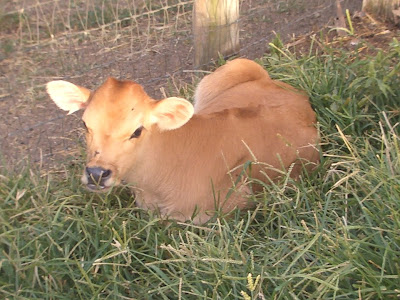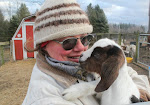I knew it was only a matter of time before some animal rights whack-job sent me a nasty-gram over the fact that we raise veal calves. The following was sent to my home e-mail account from a generic Yahoo account and said:
I can only hope that in your next life you come back as a veal calf.
You're an evil whore, sub-human, devil. May you be gang-raped, struck with cancer and your children fall to disease and suffering.
Karma makes the world go round. enjoy it. nine474@yahoo.com
 A group of similar-aged calves raised together. They have room to run, shelter, grass and there are never more than six to a group so no one gets pushed out for food.
A group of similar-aged calves raised together. They have room to run, shelter, grass and there are never more than six to a group so no one gets pushed out for food.All of our bull calves come from a local dairy farm that is approximately three miles away. The calves are only transported one or two at a time over a very short distance and not until they are several days old. The calves are typically left with their mothers 24-48 hours after they are born, some that are born out on far pastures are on their mothers for as long as a week. Commercial veal calves are pulled from their mothers within minutes of being born and often transported within the first 48 hours. Many do not receive the first milk, called colostrum, which provides the necessary antibodies for healthy animals. Once at Painted Hand Farm, the calves are grouped according to age. Since we don't raise hundreds of calves at a time (there are 14 out there right now, with one on the way after he gets a good start at the dairy farm), we can devote the best of care to the animals we have. Calves are never put in groups of more than six at a time. That's three 'mommy buckets' per group. And speaking of how we feed them, commercial veal operations generally feed milk out of buckets instead of nipples.  "Mommy-buckets" feed two calves at a time.
"Mommy-buckets" feed two calves at a time.
 "Mommy-buckets" feed two calves at a time.
"Mommy-buckets" feed two calves at a time. This is unnatural for the calves and often contributes to health problems. Watch a calf suck from a bottle (or get in the pen with a mob of hungry ones) and you will see that calves produce a copious amount of saliva. The saliva has a number of advantageous properties, anti-microbial and aiding in digestion.
More importantly, we pride ourselves on what we feed our calves---NO ANTIBIOTICS, NO HORMONES and NO MILK REPLACER THAT CONTAINS BLOODMEAL AND OTHER UNNATURAL PROTEIN PRODUCTS. We have a family milk cow from who we draw off all of her cream with which I make cultured butter. That leaves lots of skim and buttermilk to supplement the powdered milk replacer that is non-medicated and contains no bloodmeal---only powdered milk. Calves are NEVER fed straight replacer. Additionally, the dairy often has excess milk from fresh cows that can not be put into the bulk tank and would otherwise be put down the drain. What a waste!  No tiny, cramped indoor crates on this farm. Lots of room to run in the green grass.
No tiny, cramped indoor crates on this farm. Lots of room to run in the green grass.
 No tiny, cramped indoor crates on this farm. Lots of room to run in the green grass.
No tiny, cramped indoor crates on this farm. Lots of room to run in the green grass.Our daughter worked on a commercial veal farm for nearly two years and this is how those calves were raised. They would arrive on a trailer crowded together from multiple farms from miles and miles away. Often their umbilical cords would still be wet as their trucks made multiple pick-ups during the week. They would be force-fed something she called "Smurf Juice" which was a mixture of glucose and antibiotics. They were put into individual pens in an indoor room housing as many as 300 calves at a time. They were fed cold medicated milk replacer in buckets, along with grain (instant diarrhea, the number one killer of calves). Living in crowded conditions and being exposed to all sorts of bacteria and viruses without the benefit of immunity passed through colostrum, they were often ill and thus, requiring the use of injectable broad spectrum antibiotics such as Mycotil (deadly to humans), Naxel and Nuflor.  Raised the way nature intended.
Raised the way nature intended.
 Raised the way nature intended.
Raised the way nature intended. I think calves are one of the most delicate creatures on the farm. Stress creates an upset that can kill them within hours and commercial operations expect a 10% mortality. So why raise veal? First, they are a by-product of the dairy industry. If you drink milk, eat butter, cheese, ice cream or any other dairy product, you are contributing to the veal industry. Cows need to calve in order to produce milk. Roughly 50% of all animals born on the farm are male and the law of livestock is "if you're male, you're meat". Thanks to sexed semen, many farmers are significantly reducing the number of bull calves born on the farm.  Room to roam and grow.
Room to roam and grow.
 Room to roam and grow.
Room to roam and grow.When it comes time for our calves to be harvested...yes, they are a renewable crop therefore they are harvested....they are not crowded on to a big tractor trailer double-decker and hauled hundred (if not thousands) of miles to the processor where they are smooshed into crowded, high stress pens prior to slaughter. Instead, they travel in a small stock trailer, no more than three at a time, to a local (less than an hour) abattoir. The holding area is clean, open and uncrowded and I have never seen them use a hot stick (electric cattle prod) to move animals off of the trailer. They are slaughtered the same day they are transported, minimizing stress further. Transported in a roomy stock trailer that is never overcrowded. Yes, that's a goat. The calves are in the front.
Transported in a roomy stock trailer that is never overcrowded. Yes, that's a goat. The calves are in the front.
 Transported in a roomy stock trailer that is never overcrowded. Yes, that's a goat. The calves are in the front.
Transported in a roomy stock trailer that is never overcrowded. Yes, that's a goat. The calves are in the front.Here at Painted Hand Farm we are dedicated to sustainable agriculture. That means maximizing farm profits while continuing to farm in an environmentally and socially responsible manner. I find nothing wrong with taking what some consider a useless by-product, raising it as humanely and environmentally sound as possible and turning it into a safe and local food product.
The truth is that people have been eating veal for thousands of years. Go read your Bible and see how many references there are to calves--the fattened calf to celebrate the return of the Prodigal Son. Calves are referenced in Samuel, Jeremiah, Amos, Malachai, Psalms and Isiah, as well. Early Egyptians and Babylonians worshiped bulls and calves, meaning they sacrificed and ate them. So, what's the big difference today when we have a barbecue and give thanks for the meal?








Very informative post - I have bottle-raised milk calves - one or two at a time - much the same way - but fed them out to a larger "beef-steer" market weight. I have only known about the "commercial" way to raise veal calves and did not approve. Your way is perfect - and after your explanation no one should object. Marcia in Wyoming
ReplyDeleteGo, Sandra, Go! That e-mail made my blood boil and it takes alot to tick me off. I have lived on a farm for all of my 37 years and there is still ALOT that I am still learning about farming. But one thing that I do know is that there are some really stupid people in this world that should not have access to computers or the ability to voice their absurb opinions. Way to go, Sandra...now I'm ticked.
ReplyDeleteYou are a loveing, humane caretaker of Veal Calves. Your Standards are high and the pictures of your Veal Calves is proof. You're not makeing it up, some farmers (not you) practice this inhumane way of raising Veal Calves. My sister lives on a crop farm in Iowa and was on vacation in another state & invited to see the calves on a farm. She was horrified. The calves were in the dark standing in muck. Their eyes were a deathly blue and they were crowded & couldn't move around. They had straps that held them up because they were too weak to stand and because they were too weak to stand she was told they were piled in the truck when it was time for them to go to market. She was just sick about it. This is fresh in my memory because she just told me about it this morning.
ReplyDeleteThank you for the wonderful person you are.
Here, here. You make a sound case for your approach to sustainable agriculture and show genuine concern for how your animals are raised. I agree that anything that someone sends anonymously should be discounted. How strong can those hateful convictions be if they aren't willing to stand behind them?
ReplyDeleteI have to agree with Anne. Those calves look to me like they have a great life!
ReplyDelete